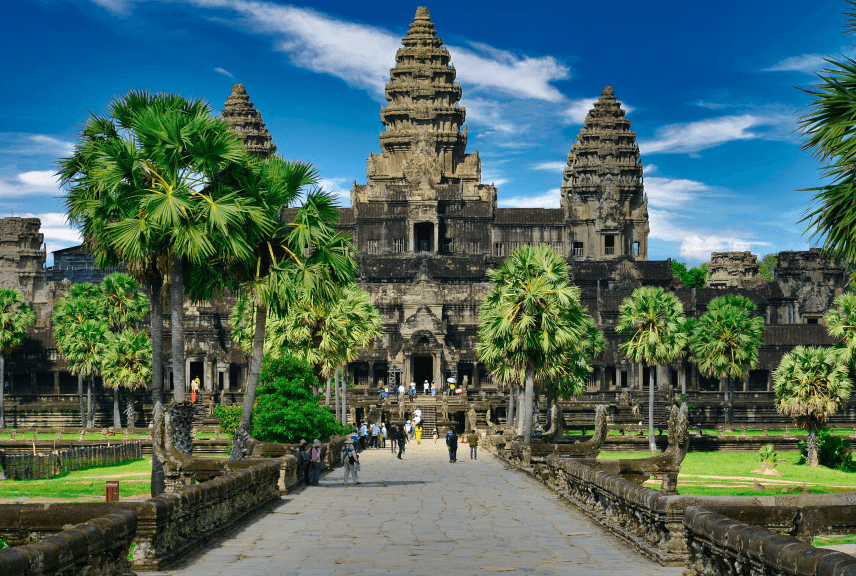Cambodia » Phnom Penh Hotels
First recorded a century after it is said to have taken place, the legend of the founding of Phnom Penh tells of a local woman, Old Lady Penh (Duan Penh,) living at the chaktomuk, the future Phnom Penh. It was the late 14th century and the Khmer capital was still at Angkor near Siem Reap 350 km (220 mi) to the west. Gathering firewood along the banks of the river, Lady Penh spied a floating koki tree in the river and fished it from the water. Inside the tree she found four Buddha statues and one of Vishnu (the numbers vary on different tellings.)
The discovery was taken as a divine blessing, and to some a sign that the Khmer capital was to be brought to Phnom Penh from Angkor. To house the new found sacred objects, Lady Penh raised a small hill on the west bank of the Tonle Sap River and crowned it with a shrine, now known as Wat Phnom at the north end of central Phnom Penh. ‘Phnom’ is Khmer for ‘hill’ and the Lady Penh’s hill took on the name of the founder, i.e. Phnom Duan Penh, and the area around it became known after the hill – Phnom Penh. Phnom Penh first became the capital of Cambodia after Ponhea Yat, king of the Khmer Empire, moved the capital from Angkor Thom after it was captured and destroyed by Siam a few years earlier. There is a stupa behind Wat Phnom that house the remains of Ponhea Yat and the royal family as well as the remaining Buddhist statues from the Angkorean era. In the 17th century, Japanese immigrants also settled on the outskirts of present-day Phnom Penh. A small Portuguese community survived in Phnom Penh until the 17th century, undertaking commercial and religious activity in the country.
Phnom Penh remained the royal capital for 73 years—from 1432 to 1505. It was abandoned for 360 years—from 1505 to 1865—by subsequent kings due to internal fighting between the royal pretenders. Later kings moved the capital several times and established their royal capitals at various locations in Tuol Basan (Srey Santhor), Pursat, Longvek, Lavear Em and Udong.
It was not until 1866, under the reign of King Norodom I (1860–1904) the eldest son of King Ang Duong, who ruled on behalf of Siam, that Phnom Penh became the permanent seat of government and capital of Cambodia, and also where the current Royal Palace was built. Beginning in 1870, the French Colonialists turned a riverside village into a city where they built hotels, schools, prisons, barracks, banks, public works offices, telegraph offices, law courts, and health services buildings. In 1872, the first glimpse of a modern city took shape when the colonial administration employed the services of a French contractor Le Faucheur, to construct the first 300 concrete houses for sale and rental to the Chinese traders.
By the 1920s, Phnom Penh was known as the Pearl of Asia, and over the next four decades Phnom Penh continued to experience rapid growth with the building of railways to Sihanoukville and Pochentong International Airport (now Phnom Penh International Airport). Phnom Penh’s infrastructure saw major modernisation under the rule of Sihanouk.
During the Vietnam War, Cambodia was used as a base by the North Vietnamese Army and the Viet Cong, and thousands of refugees from across the country flooded the city to escape the fighting between their own government troops, the NVA/NLF, the South Vietnamese and its allies, and the Khmer Rouge. By 1975, the population was 2-3 million, the bulk of whom were refugees from the fighting. The Khmer Rouge cut off supplies to the city for more than a year before it fell on April 17, 1975. Reports from journalists stated that the Khmer Rouge shelling “tortured the capital almost continuously,” inflicting “random death and mutilation” on millions of trapped civilians. The Khmer Rouge forcibly evacuated the entire city after taking it, in what has been described as a death march: Francois Ponchaud wrote that “I shall never forget one cripple who had neither hands nor feet, writhing along the ground like a severed worm, or a weeping father carrying his ten-year old daughter wrapped in a sheet tied around his neck like a sling, or the man with his foot dangling at the end of a leg to which it was attached by nothing but skin”; John Swain recalled that the Khmer Rouge were “tipping out patients from the hospitals like garbage into the streets….In five years of war, this is the greatest caravan of human misery I have seen.” All of its residents, including those who were wealthy and educated, were evacuated from the city and forced to do labour on rural farms as “new people”. Tuol Sleng High School was taken over by Pol Pot’s forces and was turned into the S-21 prison camp, where people were detained and tortured. Pol Pot sought a return to an agrarian economy and therefore killed many people perceived as educated, “lazy”, or political enemies. Many others starved to death as a result of failure of the agrarian society and the sale of Cambodia’s rice to China in exchange for bullets and weaponry. The former high school is now the Tuol Sleng Genocide Museum, where Khmer Rouge torture devices and photos of their victims are displayed. Choeung Ek (The Killing Fields), 15 kilometres (9 mi) away, where the Khmer Rouge marched prisoners from Tuol Sleng to be murdered and buried in shallow pits, is also now a memorial to those who were killed by the regime.
The Khmer Rouge were driven out of Phnom Penh by the Vietnamese in 1979, and people began to return to the city. Vietnam is historically a state with which Cambodia has had many conflicts, therefore this liberation was and is viewed with mixed emotions by the Cambodians. A period of reconstruction began, spurred by the continuing stability of government, attracting new foreign investment and aid by countries including France, Australia, and Japan. Loans were made from the Asian Development Bank and the World Bank to reinstate a clean water supply, roads and other infrastructure. The 1998 Census put Phnom Penh’s population at 862,000; and the 2008 census was 1.3 million.













